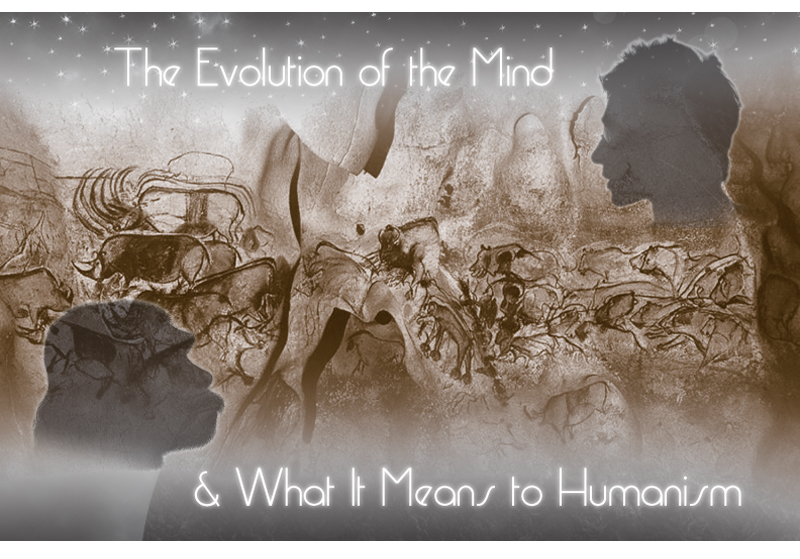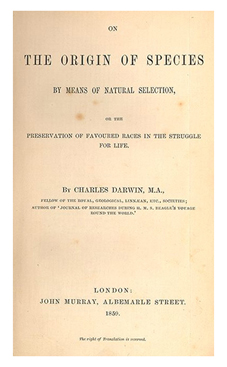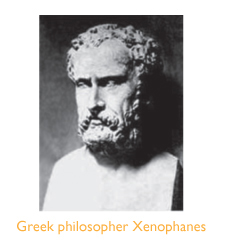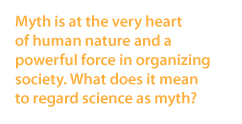The Evolution of the Mind and What It Means to Humanism

Charles Darwin’s On the Origin of Species appeared in 1859 and revolutionized how the science and religion enterprises viewed human nature. Scientists proceeded to populate the many rooms, nooks, and crannies of Darwin’s edifice with detailed evidence of the fascinating realities of evolution. Many in the religion enterprise reacted with horror and revulsion, but most came to accept evolution, however slowly and incompletely, by rewriting their theologies. One fairly recent outgrowth of Darwin’s legacy is the investigation of the evolution of religion by cognitive scientists using the tools of biology, psychology, anthropology, and paleontology, with a strong dose of history and philosophy thrown in.
 Cognitive science tells us that the human brain–the hardware whose software is the mind–collects sensory data, evaluates it, decides what to do, and commands action. Reflexive thought induces immediate action (rebalancing your body when tripping). Inferential thought draws on habits learned from experience with little to no analysis (voting for Sarah Palin because she fits your hero image). Reflective thought draws on the whole of one’s knowledge and experience to chart a course of action (staying up all night to assess what to do about your shrinking retirement portfolio).
Cognitive science tells us that the human brain–the hardware whose software is the mind–collects sensory data, evaluates it, decides what to do, and commands action. Reflexive thought induces immediate action (rebalancing your body when tripping). Inferential thought draws on habits learned from experience with little to no analysis (voting for Sarah Palin because she fits your hero image). Reflective thought draws on the whole of one’s knowledge and experience to chart a course of action (staying up all night to assess what to do about your shrinking retirement portfolio).
Religion and science are the products of reflective thought. However, all reflection begins with inferential thought. In other words, when your inferences don’t seem to compute you want to think things over. For example, if you prayed to God for a puppy on your birthday three years in a row and it never came, you might reflect on the efficacy of prayer. Something like this has been happening in the evolution of intelligent human minds for a long time. But how exactly has it happened?
Steven Mithen’s The Prehistory of the Mind describes the precursor to our modern minds as one of a general intelligence enriched by specialized modules for social intelligence, natural history, and technology. As these independent modules evolved to communicate with each other, art, religion, and agriculture became possible. Citing artifact evidence from primate and human sites, Mithen explores the evidence for evolving intelligence, culminating in the amazing modern minds that painted the Chauvet Cave 32,000 years ago with stunningly accurate images of animals. Mithen calls this milestone the “the Big Bang of human culture,” the time when causal thought became manifest―again, enabled by the integration of the intelligences.
Causal thought involves spirit causality and material causality. With great imagination, Stone Age people invented the material and spiritual concepts that redefined the norms of human cognition―morphing our minds into the reflective thought engines that powered the cultural evolution of civilization. Such causal thought exploited two cognitive tools from the primate past, agent detection and theory of mind.
Agent detection is a deeply imbedded inferential cognitive process by which humans and animals decide whether to ignore, fight, flee, pursue, or engage when encountering an agent (this being anything the animal or person believes acts with intent). For humans, agents include living people and their spirits after death, along with spirits and gods in nature believed to have a will and powers that can help or harm us. When an agent is detected, theory of mind (the ability to attribute mental states such as beliefs, desires, and knowledge to oneself and others) immediately comes into play by inferring how the agent is likely to respond.
And so for Stone Age people, spirits caused everything that happened on earth or in imaginary spiritual realms. Spirits caused rain to fall, rivers to flow, sun to shine, fruit to grow, herds to migrate, and enemies to invade. People invented myths for explaining the minds of those spirits, who craved gifts, respect, obedience, and adulation just like people in authority. They prayed to the spirits to nurture, defend, and not harm them. They offered sacrifices because that’s what powerful people, and hence spirits desire. Mithen explains: “Upper Paleolithic period hunters were living in a landscape full of symbolic meanings. For them there are not two worlds of persons (society) and things (nature), but just one world–saturated with personal powers and embracing both human beings, the animals and plants on which they depend, and the landscape in which they move.”
Only gradually did people come to discern material causes. The first record is from the Greek philosopher-satirist Xenophenes, circa 550 BCE: “The Ethiopians say that their gods are flat-nosed and black, while the Thracians say that theirs have blue eyes and red hair. Yet if cattle or horses or lions had hands and could draw, and could sculpture like men, then the horses would draw their gods like horses, and cattle like cattle; and each would shape bodies of gods in their own likeness.” Greek material causality would flourish for several hundred years among an elite minority. But most of the world remained mired in spirit causality, including Hellenistic Greece itself. Why this setback? 
Scientific thinkers morphed spirit into material causality via empirical concepts such as mass, gravity, energy, magnetism, relativity, fundamental particles, order, complexity, and evolution. Such “spirits” are part of a system of impersonal natural forces that work together without any intent to configure the universe. In fact they are no longer understood to be spirits with minds, but as the building blocks for understanding nature. But the great majority of science-ignorant people remain fixated on spirit causality because it’s firmly rooted in their minds, and needs higher education to tame it. Twenty years ago Edward O. Wilson had already concluded what recent cognitive science has validated: “The mind will always create morality, religion, and mythology, and empower them with emotional force. The mental processes of religious belief represent programmed predispositions incorporated into the neural apparatus of the brain by thousands of years of genetic evolution. As such they are powerful, ineradicable and at the center of human social existence.”
Spirit and material causality are the engines of human behavior, and hence of the religious and scientific thought that shapes human relations and the social order. Authoritarian and humanistic ethics can be the outcome of either mindset. Chauvinism and xenophobia drive society to the former, while empathy and altruism to the latter. In The God Delusion, Richard Dawkins describes the Darwinian origins of altruism and other behavioral urges in terms of a moral grammar instinct.
Natural selection in ancestral times, when we lived like baboons, programmed into our brains altruistic urges, alongside with sexual urges, hunger urges, xenophobic urges and so on. The same is true of the urge to kindness–to generosity, to empathy, to pity. Driving our moral judgments is a universal moral grammar of the mind that evolved over millions of years to include a set of principles for building a range of possible moral systems. As with language, the principles that make up our moral grammar fly beneath the radar of our awareness.
At the opposite end of altruism in Dawkins’ moral grammar, fear of others makes warfare integral to human culture. In Before the Dawn, Nicholas Wade observes: “The templates for chimp and human social behavior are very similar in a central feature, that of territorial defense and the willingness to solve the problem of a hostile neighboring society by seeking its elimination. Chimpanzee groups, like primitive human societies, are held together by bonds of kin relationships.” In religious tradition, loyalty is “good” but disloyalty is “evil,” and may justify holy war even against kin.
There is no Darwinian standard for human ethics–only a malleable “moral grammar” that protects the in-group and potentially harms the out-groups. In-group cohesion seems to require out-groups, real or invented. War is waged for material gain, but is often supported by the idea of competing spirits–my gods are stronger and more moral than yours, God is on my side, or other ideology. In the Bible, extermination of Canaanites was moral because the inhabitants of coveted lands worshipped gods other than Jehovah-Elohim. For Nazis, the appropriation of Slavic lands and enslavement of the people was moral because they were racially inferior. Mass murder of Jews was likewise moral because it prevented racial pollution while enriching the Nazi elite. Bush era torture of prisoners and the Abu Ghraib human pyramid was moral because God hates terrorists who merit neither legal nor moral protections in a holy war against them. In all these cases the perpetrators targeted out-group human agents and manipulated in-group theory of mind to demonize them–a standard method of leaders of religious as well as secular ideologies for inciting violent mob action.
Like traditional religions, humanism offers a vision of an idealistic social order. But some popular misconceptions about religion and science diminish the humanist movement’s potential. For example: God-belief is always contrary to science and socially harmful; religion is the root cause of human conflict; myths only propagate superstition; science and reason alone can save humanity from ecological and social disaster.
On the contrary, religion can support science and does confer social benefits. Religion also conveys humanistic principles like social justice and liberation.The actual root causes of human conflict are the instincts to kill or harm competitors as if group survival depended on it–whether or not that’s the case. Myths are stories that express attitudes toward reality such as identity, ethical stance, and principles of social order–whether the stories are supernatural or merely fictional. And science and reason are necessary but not sufficient conditions for improving society.
The largest truth is that religion reflects the conflicted moral grammar that evolution has programmed into human minds. E. O. Wilson understood this when he wrote “the evolutionary epic is probably the best myth that we will ever have!” Some of my humanist friends find this notion preposterous even though the honored Wilson said it. I encourage them to consider that myth is at the very heart of human nature and a powerful force in organizing society. What does it mean to regard science as myth? It means applying the understanding of the world that science conveys to shaping our attitudes about social living. Science as myth challenges us to define what is truly important for human wellbeing–what religions call sacred–in ways that can actually influence our minds more effectively than any science dissertation or textbook.
 Science writers like astrophysicist Eric Chaisson (Epic of Evolution: Seven Ages of the Cosmos) educate readers about humanity’s place in the natural world. What makes such books interesting is how they convey the awe, wonder, and mystery that science inspires. Some would call these emotions spiritual or religious. Big Bang theory and evolution are grounded on strict material causality. However, the human instincts, drives, and emotions that motivated countless spirit creation myths also motivate the scientific search for primal origins and for extraterrestrial life. It is ironic that the causal thought that enabled Stone Age survival also enabled the evolution of the science and technology that now threatens the survival of us all.
Science writers like astrophysicist Eric Chaisson (Epic of Evolution: Seven Ages of the Cosmos) educate readers about humanity’s place in the natural world. What makes such books interesting is how they convey the awe, wonder, and mystery that science inspires. Some would call these emotions spiritual or religious. Big Bang theory and evolution are grounded on strict material causality. However, the human instincts, drives, and emotions that motivated countless spirit creation myths also motivate the scientific search for primal origins and for extraterrestrial life. It is ironic that the causal thought that enabled Stone Age survival also enabled the evolution of the science and technology that now threatens the survival of us all.
Darwinian laws have no right or wrong–just scientific principles of survival with winners and losers. For humanity to remain a Darwinian winner, we must support human rights and respect the ecosystem. Myths informed by science can have a profound influence on both humanist attitudes and those of the majority who live by spirit myths. Facts and figures alone do not motivate action unless they trigger the deeply seated human instincts symbolized by myths. In The Creation: An Appeal to Save Life on Earth,Wilson appeals to biblical myths about the sanctity of life and nature to convince his fictive Christian of the sacred obligation to help rescue God’s creation. But science-inspired myth need not be wrapped in supernatural notions. The Gaia myth of interconnected life and the American myth that people were created equal can motivate a more humanistic religious and hence political life.
Even atheists subconsciously share spirit causality with all humans along with sex, hunger, and other physiological drives. A life of pure reason is unattainable because our subconscious minds are filled with non-rational instincts, drives, and emotions that have their own Darwinian logic. If this seems credulous just think about your surrealist dreams in which dead relatives come to visit. Nevertheless, a reason-driven life on balance is essential to tame the Stone Age spirits that haunt our species and threaten its survival. Walter M. Miller’s A Canticle for Leibowitz is a science fiction classic of mythic proportions that tells the story of a post-nuclear war America circa 3000. It is a world ruled by warlords, in which a network of monasteries worship relics of the nuclear industry while fostering the re-creation of the science enterprise that enabled the bomb–a surrealistic allegory of the misuse of religion and science.
All this suggests that we need to rethink how we advocate the humanist social agenda, which includes freedom of religion and from religion, a secular and democratic state, social equity, and a healthy ecosystem. God-believers who share this core agenda are natural allies. The notion that an atheistic humanism alone can rescue humanity from the perverse threats of its own nature is folly. To implement our agenda we need the masses of religious people who, in spite of spirit beliefs, can support science, reason, and respect for atheists. There are of course fanatics, whose denials threaten and affront us–but they also threaten and affront our religious allies. While humanists cannot alter the minds of people to expunge mythic expression, we can help them rethink and reshape their myths to serve universal humanist longings, independent of spirit belief. Criticism of religion should engage, but not antagonize our natural allies. This means focusing on how the abuse of religion, especially its use of myths to inspire xenophobia and war, harms us all. This is not a religious activity, but a social and political one that transcends religion.
I am encouraged by a seriously Catholic volunteer for the Obama campaign who was outraged by fanatics who would ban her right to practice contraception or to have an abortion. Humanist allies, like Martin Luther King Jr. and Barack Obama, who preach and practice Jesus’s social gospel in the political arena, demonstrate that humanism indeed crosses spiritual boundaries–and we ignore that reality only at our peril.
